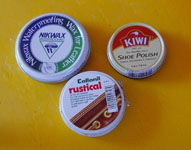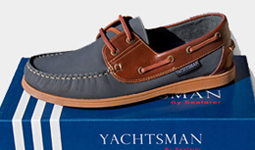Categories:
On the list we send to clients we specify ‘suitable shoes’. Traditional boat shoes are not always the best for sailing in Greece and so I thought it might be useful to explain what to choose.

What are “Boat Shoes”?
Boat shoes, also referred to as ‘deck shoes’, were designed as tough, sturdy shoes with particularly good traction to keep sailors on their feet in wet weather and on slippery decks. I have read that they were based on North American Indian moccasins.
A good pair of boat shoes should fit snugly, but comfortably. Your foot should not slide around in them but your toes should not be cramped. The most important feature of a boat or deck shoe is the sole. Boat shoe soles should have a lot of grip and really keep your feet where you plant them. The whole purpose of these shoes is to help keep you upright on a slippery deck. Sometimes with laces, but more often without, boat shoes are also designed to be easy to slip on and off.
As well as having good grip, the sole should be non-marking – with a small, often honeycomb patttern and in a light colour. This is important on modern GRP boats.

Who Needs Shoes Anyway?
Unless you are sailing with us between October and March, you’ll probably spend most of your time on board barefoot. It’s one of the nice things about sailing.
Bare feet are fine for during the day but there are times when you will need to have shoes.
You should always protect your feet when you are using the anchor or stepping ashore.
Key things to look for in boating shoes for Greece are:
Plimsolls and Canvas Deck Shoes

Canvas plimsoles, either lace-up or slip-on, are a good footwear solution for our climate and what we would recommend. Remember to choose a light coloured honeycomb sole.
At the moment they are enjoying a revival as the coolest, latest style in retro chic so should be easy to find.
Buy them cheap and cheerful or go for a designer label if you want to make a fashion statement.
The Waterproof Option
Bright and colourful as well as waterproof, shoes like these below (from Lands End) are suitable for wearing on both yachts and RIB.

They feature fast-draining mesh uppers and rubber footbeds and soles with drainage holes. Thy’re great for dinghy work and you can even wear them swimming.
Traditional Leather Boat Shoes
 This is a typical leather boat shoe as sold by marine chandlers. They are made for use on board with soles of a non-marking material.
This is a typical leather boat shoe as sold by marine chandlers. They are made for use on board with soles of a non-marking material.
These shoes can be worn in the cooler months of the year as well as mid summer and are useful if you want to sail in places other than the Mediterranean.
Being leather, they tend to be more expensive than canvas deck shoes.
 Leather boat shoes need to be regularly cleaned and cared for to keep the leather supple and in good condition.
Leather boat shoes need to be regularly cleaned and cared for to keep the leather supple and in good condition.
Use a leather feeder for a waterproof seal that prolongs the life of the shoe. We recommend Nikwax or Collonil Rustical. Neutral Kiwi is also suitable. (available in climbing shops if you cannot find them in a shoe shop.)
 A word of warning ….
A word of warning ….
Some boat shoes have dyed leather. Although this looks smart, we have found a drawback to these in Greece. Worn without socks they have a tendency to stain your feet if your feet perspire or the shoes get wet and the dye runs!
Machine washable deck shoes
 I owned a pair of these Quayside Bermudas for many years and really loved the fact that they could be popped into the washing machine when dirty. Unfortunately I have to report that they suffered very slightly from the same problem of dye leaking, although this was not a major problem. Worth it for the convenience if you will be sailing a lot.
I owned a pair of these Quayside Bermudas for many years and really loved the fact that they could be popped into the washing machine when dirty. Unfortunately I have to report that they suffered very slightly from the same problem of dye leaking, although this was not a major problem. Worth it for the convenience if you will be sailing a lot.
If your deck shoes have removable liners, regularly take them out and spray them to keep them fresh and clean.
Where to Get Them
If you can’t find suitable shoes in your local shops, or don’t have time to look, try online sites such as ebay and Amazon. An Internet search for ‘deck shoe’, for instance, will come up with numerous companies who sell online.
You can try ebay for good prices and Boat Shows often have branded shoes at a special price.
Read what some of our sailing students have to say, explore our course catalogue, and contact us for more information about each course and our availabilities to come and sail in Greece!